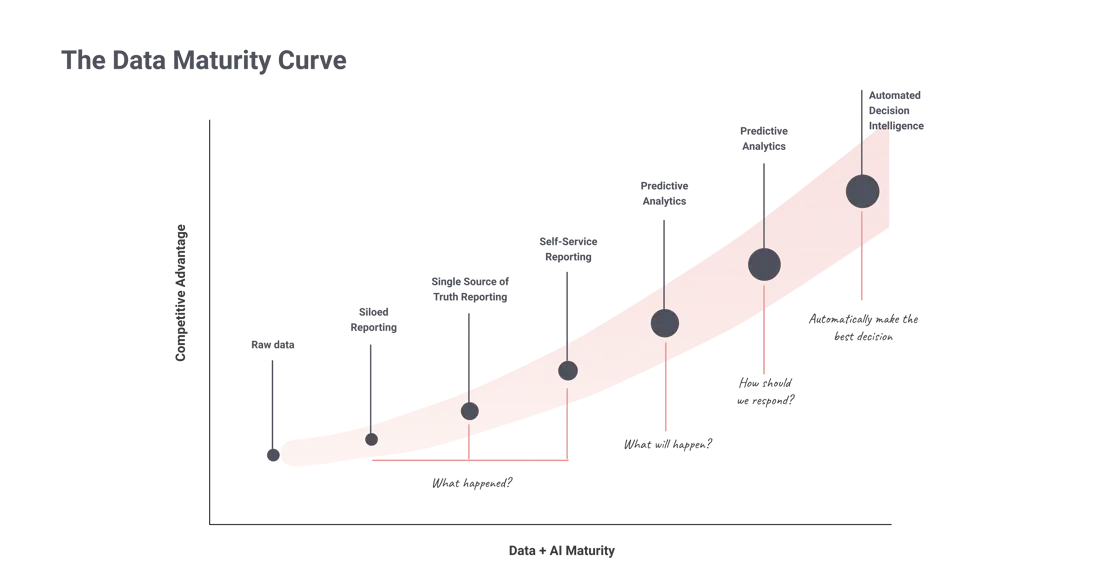Demystifying data by design

Data is often treated as a dark art—an exclusive club where only wizards and alchemists dare tread. But actually once you look behind the curtain you’ll see that data is simply another tool in your belt, a powerful tool, but a tool nonetheless.
I’ve spent the last five years working closely with data teams, even stepping into a leadership role in data—an amusing twist, considering my background is in human-centred design. Yet this outsider perspective turned out to be an advantage. I approached data from a place of curiosity, and discovered that data doesn’t have to be intimidating. It can be simple, accessible, and downright transformative—if you stay curious and know where to look.
So let me share what I’ve learned. I’ll demystify data and explain how you can unlock its potential to drive more informed decisions, more efficient processes, and more engaging customer experiences. By the end, you’ll see that data is not just for the “geniuses”—it’s for anyone willing to explore its possibilities.
Data is the new black gold, Texus Tea.
Back in 2006—right on the cusp of the modern technology revolution—British mathematician and data scientist Clive Humby famously declared: “Data is the new oil.” Over the following decades, many of us took that proclamation to heart, stockpiling data in every corner of our organisations in anticipation of reaping future rewards. Even if we weren’t entirely certain how to use it, we knew that somewhere in all those bytes lay untapped value.
One recent survey found that 24% of businesses manage a petabyte of data (that’s 1,000 terabytes), and 41% manage between one and five hundred petabytes. Translation? Most organisations already have more than enough data on hand. In fact, that same report found 88% of respondents wrestled with too much data, rather than too little—raising issues around accuracy, integrity, and overall data excess.
And just like oil, raw data isn’t automatically valuable. It’s often messy, incomplete, or locked away in silos—brimming with potential but not yet fit to power the advanced technologies that define the modern age, such as AI, automation, and predictive modelling. Only when data is cleaned, structured, and made accessible does it shift from a mere resource to the driving force behind smarter decisions, innovative tools, and lasting organisational impact.
That’s where the true value lies: not in amassing as much data as possible, but in refining it into actionable insights.
But where to start?
The real challenge is uncovering and connecting all that data so it can actually be used. That’s why, when planning any digital transformation project, it’s crucial to focus on:
-
Centralise your data. Whether that’s in the cloud, a data lake, a lakehouse, or a warehouse, the key is making data easily accessible. When your people, processes, and software all draw from a single source of truth, they can be far more effective.
-
Fix the flow and find the gaps. If you’re missing the data you need to make informed decisions, analyse interactions, or predict outcomes, you’ll need to pinpoint where the supply chain breaks down—and patch those holes.
-
Integrate offline data. There’s a treasure trove of insights locked away in paper-based processes and Excel spreadsheets. By digitising these sources and linking them to your central ecosystem, you’ll get a more complete picture of your organisation—and yield richer, more actionable insights. In my experience, every digital transformation project I’ve seen pays off—not just in reducing time on task, but in cutting errors too.
This might sound daunting, but data management is often more straightforward than it appears. Most of the work comes down to setting up a clean, sensible ecosystem—one that continually and reliably unlocks the value hidden in your organisational data.
Source: Kleene - The Data Maturity Curve
Why a clean data ecosystem matters
A well-structured data environment is a powerful driver of organisational performance. It doesn’t just ensure data is in the right place at the right time—it sets the stage for meaningful insights and sustainable growth. Here’s how:
-
Improve efficiency: By scrutinising data and reports, you can spot inefficiencies, waste, financial losses, and hidden costs. You can then benchmark your fixes to see what’s really moving the needle.
-
Leverage advanced technologies: Accurate, consistent data underpins AI models, analytics tools, automation platforms, and dashboards, giving you a competitive edge in an ever-evolving marketplace.
-
Enhance employee and customer experiences: Data is a goldmine for understanding preferences and behaviours. Tap into it to shape engagement strategies, develop targeted marketing, and create genuinely satisfying experiences.
-
Reduce costs and errors: In a mature data ecosystem, people and software rely on a single source of truth, minimising double-handling and human error while boosting overall confidence in your data.
-
Predict trends and events: When data is organised and transparent, you can uncover hidden patterns, anticipate emerging trends, and even experiment with advanced AI or machine learning for predictive insights.
How to transform your data ecosystems
Data ecosystems can often feel like untapped oil fields—vast, disjointed, and difficult to harness. At equ, we believe that thoughtful design, guided by Human-Centred Design principles, is the key to transforming messy, siloed data systems into streamlined, efficient ecosystems.
“What’s design got to do with it?”
As Tina Turner once asked, “What’s design got to do with it?” When it comes to data, the answer is: a lot. Data deserves just as much strategic and creative focus as any development project. After all, you wouldn’t (or shouldn’t) build an app without careful planning, design, and user consideration—and data projects are no different.
Yet, this is where many data projects falter. Too often, they prioritise technical implementation over thoughtful design, overlooking the user experience and the broader ecosystem in which the data exists. Without a design-led approach, data projects risk becoming overly complex, disconnected, or misaligned with the needs of the people who rely on them. Design ensures that data isn’t just collected or stored—it’s made usable, accessible, and impactful, driving smarter decisions and meaningful outcomes.
Think back to the internet of the early 2000s—chaotic, clunky, and visually unappealing. It was overwhelming to navigate and far from user-friendly. Over time, thoughtful design has transformed it into an intuitive, information, and delightful experience. The same potential exists for data. By applying the right design principles, we can simplify complexity, humanise systems, and empower people to harness data in meaningful ways.
Key strategy & design activities
So, what does design look like on a data project? Surprisingly, it’s a lot like a development project. While every project is unique, there are a few tried-and-tested fundamentals that always deliver results:
Business needs analysis
We start by identifying organisational pain points, uncovering improvement opportunities, and defining metrics that align your transformation goals with core business objectives.
Current state assessment
Next, we map and evaluate your digital ecosystems, and processes. This helps us pinpoint data quality issues, accessibility challenges, security concerns, and potential silos.
Data governance & integration
Together with our engineers, we establish guidelines for data ownership, quality, and security. We also unify data sources using methods like ETL or ELT (Extract, Transform, Load), often with data lakes or warehouses for centralised storage.
Use case identification & roadmap
Once a solid foundation is in place, we prioritise high-impact use cases that align with strategic goals. We then develop a roadmap with clear milestones, timelines, and success metrics to keep your project on track.
Technology selection & digital products
We assess existing tools and explore new data analytics solutions—often cloud-based—for scalability. We also design user-centric digital products to replace outdated processes, ensuring all your data flows seamlessly into one place for deeper insights.
Change management & ongoing improvement
Any transformation affects people, so we address concerns early, provide training, and foster a data-driven culture. Finally, we commit to regular reviews of data quality, analytics outcomes, and system performance, making sure you stay ahead in a fast-evolving digital world.
By following these strategic, design-led activities, we ensure every aspect of your digital ecosystem—from governance to culture—supports lasting success. That way, your organisation remains agile, people-focused, and primed to seize opportunities in a rapidly changing landscape.
Unlock the true value of your data with equ
At equ, we see data not as a daunting dark art, but as an opportunity—one that grows exponentially when coupled with a design-led mindset and a well-planned strategy. We believe in meeting people where they are, upskilling teams to interpret data confidently, and creating user-friendly digital products that make life easier. And while the journey to a mature digital ecosystem can feel complex, the benefits are clear: reduced errors, better decisions, enhanced customer and employee experiences, and ultimately, a more agile, future-proof organisation.
Ready to turn your data into your greatest asset? Let’s work together to design a digital ecosystem that empowers your business to thrive—now and into the future. Contact us today to start the transformation.




